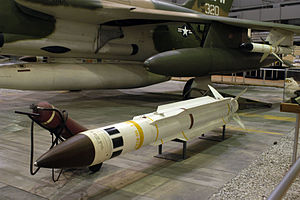AGM-78 Standard ARM
| AGM-78 Standard ARM | |
|---|---|
 |
|
| Type | Air-to-surface anti-radiation missile |
| Place of origin | United States |
| Service history | |
| In service | 1968–1988 |
| Wars | Vietnam War |
| Production history | |
| Designed | 1967 |
| Produced | 1967–1976 |
| Number built | 3,000+ |
| Specifications | |
| Weight | 620 kg (1370 lb) |
| Length | 4.57 m (15 ft) |
| Diameter | 34.3 cm (13.5 in) |
| Warhead weight | 97 kg (215 lb) blast-fragmentation |
|
|
|
| Engine | Aerojet MK 27 MOD 4 dual-thrust solid-fueled rocket |
| Wingspan | 108 cm (42.5 in) |
|
Operational
range |
90 km (56 mi) |
| Speed | Mach 1.8 |
|
Guidance
system |
Passive radar homing |
|
Launch
platform |
A-6B/E Intruder, F-105G Thunderchief, F-4G Phantom II |
The AGM-78 Standard ARM was an anti-radiation missile developed by General Dynamics, United States of America.
Originally developed for the US Navy during the late 1960s, the AGM-78 was created in large part because of the limitations of the AGM-45 Shrike, which suffered from a small warhead, limited range and a poor guidance system. General Dynamics was asked to create an air-launched ARM by modifying the RIM-66 SM-1 surface-to-air missile. This use of an "off the shelf" design greatly reduced development costs, and trials of the new weapon begun in 1967 after only a year of development. The first operational missiles were issued in early 1968.
The AGM-78 was nicknamed the "starm", an abbreviation of Standard ARM. The first version of the missile, the A1 Mod 0, was little more than an air-launched RIM-66 with the Shrike's anti radar seeker head attached to the front. An Aerojet Mark 27 MOD 4 dual-thrust solid-rocket-powered the missile, which was fitted with a blast-fragmentation warhead. Although more capable, the AGM-78 was much more expensive than the AGM-45 and the Shrike continued in service for some time. The new missile was carried by the F-105F/G and the A-6B/E.
An inert training version of the AGM-78A was built as ATM-78A. Of equal size, mass and shape, the missile lacked a seeker head, warhead, or propulsion systems and was essentially just a dead weight.
An A2 model introduced a bomb damage assessment (BDA) capability and an SDU-6/B phosphorus target marker flare to facilitate targeting of the site for follow up attacks.
In 1969 an improved model called the AGM-78B was produced. This featured a broadband seeker which allowed the missile to be used against a much wider variety of targets without having to select the seeker before the mission. A simple memory circuit was also included, allowing the missile to attack a target once it locked on, even if the radar was shut down. Previous ARMs would veer off course and miss when they lost a target, and as a result flipping the radar on and off had become a standard tactic for missile batteries.
...
Wikipedia
